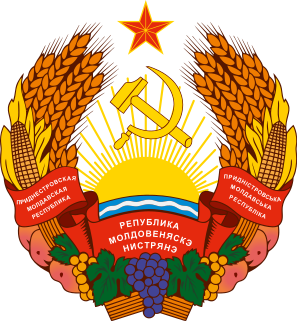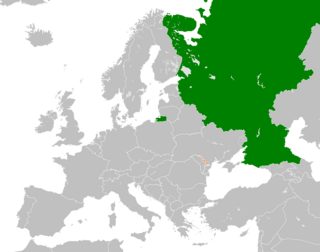Related Research Articles

Tiraspol is the capital of Transnistria, a breakaway state in Moldova, where it is the second largest city. The city is located on the eastern bank of the Dniester River. Tiraspol is a regional hub of light industry, such as furniture and electrical goods production.

Transnistria, officially the Pridnestrovian Moldavian Republic (PMR), is a breakaway state in the narrow strip of land between the river Dniester and the Ukrainian border that is internationally recognized as part of Moldova. Its capital is Tiraspol. Transnistria has been recognised only by three other mostly unrecognised breakaway states: Abkhazia, Artsakh, and South Ossetia.

The ruble is the currency of Transnistria and is divided into 100 kopecks. Since Transnistria is a state with limited international recognition and considered as part of Moldova, its currency has no ISO 4217 code. However, unofficially some Transnistrian organisations such as Agroprombank and Gazprombank used the code PRB, a code that would otherwise be reserved for Puerto Rico. The Transnistrian Republican Bank sometimes uses the code RUP.

The Transnistria War was an armed conflict that broke out in 2 November 1990 in Dubăsari between pro-Transnistria (PMR) forces, including the Transnistrian Republican Guard, militia and Cossack units, and pro-Moldovan forces, including Moldovan troops and police. Fighting intensified on 1 March 1992 and, alternating with ad hoc ceasefires, lasted throughout the spring and early summer of 1992 until a ceasefire was declared on 21 July 1992, which has held. The conflict is sometimes known as the Moldo-Russian war in Moldova and Romania.

The political status of Transnistria, a self-proclaimed state on the internationally recognized territory of Moldova, has been disputed since the Transnistrian declaration of independence on 2 September 1990. This declaration sought to establish a Soviet Socialist Republic that would be independent from local Moldovan authority. Following the breakup of the Soviet Union and Moldova's own declaration of independence in 1991, the Pridnestrovian Moldavian Soviet Socialist Republic (PMSSR) was transformed into the Pridnestrovian Moldavian Republic (PMR). However no United Nations member country recognizes the PMR's independence.
The Transnistria border customs issue started on March 3, 2006, when Ukraine imposed new customs regulations on its border with Moldova on the Transnistrian region by declaring that it will only import goods from Transnistria with documents processed by Moldovan customs offices, as part of the implementation of a joint customs protocol between Ukraine and Moldova on December 30, 2005.

This is the history of Transnistria. See also the history of Europe.

The Romanian-language schools in Transnistria are subject to limitations by the government of Transnistria, an unrecognized breakaway region of Moldova since 1992.
The Kozak Memorandum, officially Russian Draft Memorandum on the Basic Principles of the State Structure of a United State in Moldova, was a 2003 proposal aimed at a final settlement of relations between Moldova and Transnistria and a solving of the Transnistria conflict. It was seen as an extension of the 1997 Moscow Memorandum but was ultimately rejected by Moldovan president Vladimir Voronin.

The involvement of the Soviet 14th Guards Army in the War of Transnistria was extensive and contributed to the outcome, which left the Pridnestrovian Moldavian Republic (PMR) with de facto independence from the Republic of Moldova.
The mass media of Transnistria, the breakaway territory within the borders of Moldova, features both state-owned or supported outlets and opposition media. Publications are in Russian, with a single newspaper in each of the other two official languages, Moldovan (Romanian), and Ukrainian.

This timeline of events is a chronological list of incidents and other notable occurrences related to the War of Transnistria, including events leading up to the war.
Law enforcement in Transnistria is administered by the region's own police force. Transnistria functions as a presidential republic, with its own government, parliament, military, paramilitary and police (militsiya) force, constitution, currency, postal system and stamps, flag, national anthem, and coat of arms.
Ernest Vardanean is a journalist and political scientist who lives in the breakaway Moldovan region of Transnistria. He was arrested on 7 April 2010 by the self-proclaimed forces in Tiraspol charged of high treason in favor of the Republic of Moldova.
The 2012 Moldova security zone incident happened in the Transnistrian security zone maintained by the Joint Control Commission on the territory of the Republic of Moldova. On 1 January, a Moldovan civilian drove through a checkpoint in the zone and was fatally wounded by a Russian peacekeeper.
The Brasilia Presidential Act is an international treaty signed by the then President of Ecuador, Jamil Mahuad and President of Peru, Alberto Fujimori which effectively put an end to the Western Hemisphere's longest running territorial dispute.
This is a list of 2014 events that occurred in Moldova.

Transnistrian Railway is the railway operator of railways in Transnistria.

Moldova–Transnistria relations are the political and economic relations between the Republic of Moldova and Transnistria, an unrecognized state between the Dniester River and Ukraine. During the dissolution of the Soviet Union, political tensions in the Moldavian Soviet Socialist Republic led to Transnistria declaring independence from Moldova, culminating in the Transnistrian War of 1992. As part of the ceasefire agreement ending the war, a Joint Control Commission composed of Moldovan, Transnistrian, and Russian forces was established to supervise the demilitarized zone which was located in the Transnistrian region. The Joint Control Commission still supervises the zone, and negotiations to resolve the dispute are ongoing. The negotiations are supported by the Russian Federation, Ukraine, the United States, the European Union, and the Organization for Security and Co-operation in Europe (OSCE).

Russia–Transnistria relations is the bilateral relationship between the Pridnestrovian Moldavian Republic (Transnistria) and the Russian Federation. Russia does not officially recognize the independence of Transnistria; nevertheless, Russia maintains special relations with Transnistria in the political, military, cultural, and economic spheres.
References
- ↑ Uppsala Conflict Data Program Conflict Encyclopedia, Moldova, Peace Agreement, Memorandum on the Basis for Normalization of Relations between the Republic of Moldova and Transdniestria, http://www.ucdp.uu.se/gpdatabase/gpcountry.php?id=108®ionSelect=9-Eastern_Europe#
- ↑ Uppsala Conflict Data Program Conflict Encyclopedia, Moldova, Peace Agreement, Memorandum on the Basis for Normalization of Relations between the Republic of Moldova and Transdniestria, http://www.ucdp.uu.se/gpdatabase/gpcountry.php?id=108®ionSelect=9-Eastern_Europe#